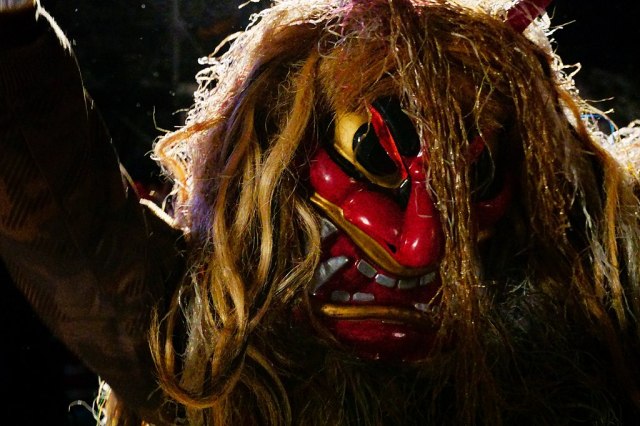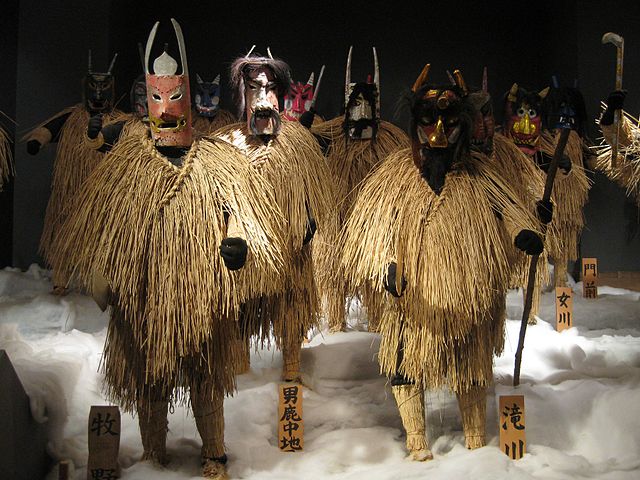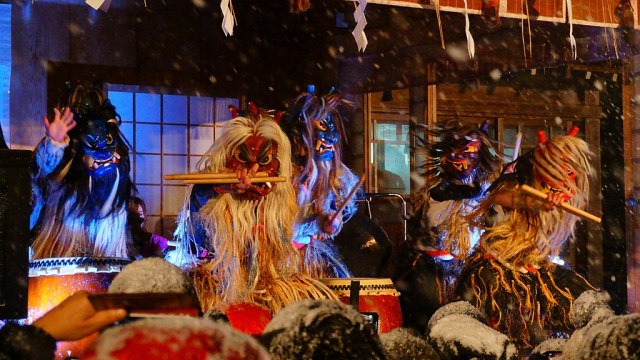
Unfortunately, kids in northern Japan don’t get a pass this year from the UNESCO-recognized, fearsome namahage.
Japan is host to a variety of traditions and rituals, some which are hundreds of years old or which have made a recent comeback. However, with the impact of COVID-19 this year, several traditional Japanese festivals and customs have been adjusted for safety concerns, and the same goes for the northern Japanese tradition of namahage in Akira prefecture’s Oga city.
▼ An assortment of namahage costumes from local areas in Akita’s Namahage Museum.
Added to UNESCO’s Intangible Cultural Heritage of Humanity list two years ago, namahage are part of an annual New Year’s Eve tradition where male volunteers dress up as straw cloak-wearing, paper mache knife-bearing oni, or ogres, who find and eat disobedient children. The typical namahage routine in Japanese villages involves visiting local homes while threateningly saying “Any naughty children around?” Another important part of the tradition as well also includes preparing a tribute of sake and mochi, or sticky rice cake, for the namahage to drink and eat.
But with COVID-19-related fears abound, things will be different for the nearly 200-year-old tradition.
▼ Other activities involving nahamage include taiko, or traditional Japanese drum performances.
For this year, as part of COVID-19 preventative measures, namahage will not be entering homes and community organizers ask that local households refrain from providing the usual spread of alcohol as well as food. Volunteers helping with the tradition will also be expected to wear face masks. However, the experience won’t be entirely lost as it’s been decided that the namahage will instead stick to roaming the streets, no doubt shouting their signature catchphrase, “Any naughty children around?” and waving a paper mache knife.
▼ No more crowds either for the time being.
Ritual-bound traditions play an important role in local communities and serve as a homage to the distinctive cultures that every region of Japan has. And while these are simply temporary measures for the namahage, hopefully in the future things will wind down enough that guests of the region can experience the special tradition of namahage while enjoying some fresh seafood.
Source: NHK
Top image: Wikipedia/掬茶
Insert image: Wikipedia/Douglas P Perkins, Wikipedia/掬茶 (1, 2)
● Want to hear about SoraNews24’s latest articles as soon as they’re published? Follow us on Facebook and Twitter!



 Yakuza leadership airs complaints about COVID-19’s effect on money gains and operations
Yakuza leadership airs complaints about COVID-19’s effect on money gains and operations Statue of comedian Ken Shimura erected a year after death from COVID-19
Statue of comedian Ken Shimura erected a year after death from COVID-19 Japanese beef bowl chain Sukiya’s 2026 Smile Box lucky bag basically pays for itself
Japanese beef bowl chain Sukiya’s 2026 Smile Box lucky bag basically pays for itself The Purple Lucky Bag from Village Vanguard is an extra-large waste of money
The Purple Lucky Bag from Village Vanguard is an extra-large waste of money Village Vanguard’s most expensive Black Lucky Bag sets an ominous tone for 2026
Village Vanguard’s most expensive Black Lucky Bag sets an ominous tone for 2026 Studio Ghibli director Hayao Miyazaki shares his beloved car with fans
Studio Ghibli director Hayao Miyazaki shares his beloved car with fans Japan’s otoshidama tradition of giving kids money at New Year’s gets a social welfare upgrade
Japan’s otoshidama tradition of giving kids money at New Year’s gets a social welfare upgrade Pizza Hut Japan’s hot lucky bags are perfect for a New Year’s pizza party
Pizza Hut Japan’s hot lucky bags are perfect for a New Year’s pizza party A diner’s guide to oden: Japan’s weird-looking, super-popular winter dish
A diner’s guide to oden: Japan’s weird-looking, super-popular winter dish Godzilla-shaped ice cream on sale in Tokyo near the sight his most adorable rampage
Godzilla-shaped ice cream on sale in Tokyo near the sight his most adorable rampage Japanese company trips – Workers “absolutely hate” them, so why do they still happen?
Japanese company trips – Workers “absolutely hate” them, so why do they still happen? Starbucks Japan ready to get Year of the Horse started with adorable drinkware and plushies【Pics】
Starbucks Japan ready to get Year of the Horse started with adorable drinkware and plushies【Pics】 Hayao Miyazaki says Happy New Year to Studio Ghibli fans with new art for Year of the Horse
Hayao Miyazaki says Happy New Year to Studio Ghibli fans with new art for Year of the Horse We found possibly the quietest Japanese-style hotel in Tokyo’s bustling Shinjuku district
We found possibly the quietest Japanese-style hotel in Tokyo’s bustling Shinjuku district Cup Noodle tries an authentic Jiro-style ramen, but something’s not quite right
Cup Noodle tries an authentic Jiro-style ramen, but something’s not quite right The best Starbucks Japan Frappuccinos we want to drink again in 2026
The best Starbucks Japan Frappuccinos we want to drink again in 2026 We revisited Sweets Paradise after a decade to see if Japan’s dessert buffet still delivers
We revisited Sweets Paradise after a decade to see if Japan’s dessert buffet still delivers That time Seiji called JASRAC to ask why he didn’t get paid royalties for his song being on TV
That time Seiji called JASRAC to ask why he didn’t get paid royalties for his song being on TV Japan’s oldest largetooth sawfish in captivity back on display in Mie Prefecture
Japan’s oldest largetooth sawfish in captivity back on display in Mie Prefecture 7-Eleven Japan starts new temporary luggage storage service in over 300 branches
7-Eleven Japan starts new temporary luggage storage service in over 300 branches Disillusionment at Tsukiji’s tourist-target prices led us to a great ramen restaurant in Tokyo
Disillusionment at Tsukiji’s tourist-target prices led us to a great ramen restaurant in Tokyo Starbucks teams up with 166-year-old Kyoto doll maker for Year of the Horse decorations【Photos】
Starbucks teams up with 166-year-old Kyoto doll maker for Year of the Horse decorations【Photos】 Tokyo considering law requiring more trash cans following litter increase in heavily touristed area
Tokyo considering law requiring more trash cans following litter increase in heavily touristed area Tokyo’s Tsukiji sushi neighborhood asks tour groups to stay away for the rest of the month
Tokyo’s Tsukiji sushi neighborhood asks tour groups to stay away for the rest of the month Tokyo event lets you travel back in time, for free, to celebrate 100 years since Showa era start
Tokyo event lets you travel back in time, for free, to celebrate 100 years since Showa era start Japan may add Japanese language proficiency, lifestyle classes to permanent foreign resident requirements
Japan may add Japanese language proficiency, lifestyle classes to permanent foreign resident requirements Sanrio theme park in Japan announces plans to expand into a Sanrio resort
Sanrio theme park in Japan announces plans to expand into a Sanrio resort Stamina-destroying “Paralysis Noodles” are Tokyo’s newest over-the-top ramen innovation
Stamina-destroying “Paralysis Noodles” are Tokyo’s newest over-the-top ramen innovation Survey asks foreign tourists what bothered them in Japan, more than half gave same answer
Survey asks foreign tourists what bothered them in Japan, more than half gave same answer Japan’s human washing machines will go on sale to general public, demos to be held in Tokyo
Japan’s human washing machines will go on sale to general public, demos to be held in Tokyo Japan’s deadliest food claims more victims, but why do people keep eating it for New Year’s?
Japan’s deadliest food claims more victims, but why do people keep eating it for New Year’s? We deeply regret going into this tunnel on our walk in the mountains of Japan
We deeply regret going into this tunnel on our walk in the mountains of Japan Studio Ghibli releases Kodama forest spirits from Princess Mononoke to light up your home
Studio Ghibli releases Kodama forest spirits from Princess Mononoke to light up your home Major Japanese hotel chain says reservations via overseas booking sites may not be valid
Major Japanese hotel chain says reservations via overseas booking sites may not be valid Put sesame oil in your coffee? Japanese maker says it’s the best way to start your day【Taste test】
Put sesame oil in your coffee? Japanese maker says it’s the best way to start your day【Taste test】 No more using real katana for tourism activities, Japan’s National Police Agency says
No more using real katana for tourism activities, Japan’s National Police Agency says Starbucks Japan reveals new sakura drinkware collection, inspired by evening cherry blossoms
Starbucks Japan reveals new sakura drinkware collection, inspired by evening cherry blossoms Updated cherry blossom forecast shows extra-long sakura season for Japan this year
Updated cherry blossom forecast shows extra-long sakura season for Japan this year
Leave a Reply